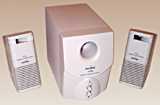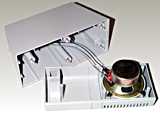
Juster 3D-102 and Encore XP200+P-703 speaker systems
Review date: 26 November 1998Last modified 03-Dec-2011.
Lots of PCs these days have kick-ass sound cards and can run entertainment software with all kinds of cool positional audio and CD background music. And yet most of these PCs are connected to really, really lousy speakers. If all you’re using is a couple of crummy two inch drivers in wafer-thin plastic boxes, you might as well have an antique SoundBlaster instead of your shiny new A3D gadget.
So what can you get for about $150 (Australian dollars)?
I checked out Juster’s 3D-102, a three piece subwoofer/satellite speaker system with a stupidly high PMPO power rating that sells for $150 Australian...
...and the related Encore XP200 subwoofer with P-703 satellites, which is actually made by the same people despite having completely different branding and packaging, and sells for less than $130 Australian.
Sub-sat systems are a handy way to get decent sound onto your desktop – the subwoofer contains the amplifier hardware for itself and the satellites, and can sit pretty much anywhere you like, with only the little satellite speakers to clutter your computer table.
What you get
Both speaker systems look pretty good. They both have subwoofer cabinets made from 3/8th inch particle board (not the crummy plastic usually seen on cheap units). The Juster has a funky moulded vent on the plastic front panel and two regular tube vents on the back, and the Encore has a single tube vent front and rear. They both have a power switch and volume control on the front, and another knob to adjust the amount of bass boost. With the bass turned all the way down, the sub is silent, and only the satellites make noise.
On the Juster sub’s rear panel are the spring terminals for the cables to the satellites; two bare wires at the sub end, RCA connectors on the backs of the satellites. RCAs should, ideally, not be used for speaker-level output, but for low powered units like these little satellites I can abandon my quibbles and go with the flow. It does make it harder to accidentally connect one or both satellite speakers backwards – and the instruction sheet quite comprehensively tells you which wire goes in which terminal.
The Juster's satellite cables may have less than perfect connectors, but at least they’re of ample length, and can of course easily be extended. The spring terminals on the sub will accept any stripped wire you like, so it’d be easy to plug better satellite speakers in. Unfortunately, the satellites use four ohm drivers, so regular hi-fi speakers would have to be used in pairs to maintain balance.
The cheaper Encore has no spring terminals; the satellite speaker cables come out of the back panel and also terminate in RCA connectors. They're less than half of the length of the Juster cables, and don't let you put the satellite speakers more than about a desk-width away from the subwoofer, unless you extend the leads.
Inside the Juster satellites there’s nothing but those little three inch paper cone four ohm drivers, and a puff of polyester lagging. Hey, most cheapo speakers aren’t even lagged...
...the Encore satellites have no such luxury. The front panels of the Juster satellites have a moulding to suggest they contain a separate tweeter, but they don’t. The Encore satellites have a small horn vent moulded into the top - their three inch drivers are much the same as the Juster ones, but are mounted in the bottom half of the satellite front panel.
Internally, the Juster sub box isn’t exactly up to Rolls-Royce construction standards. The electronics are tidy enough, with fat heatsinks on the power silicon, but one of the little wedges of wood used to brace the box panels was affixed with only a dab of hot-melt glue at one end and came off at a touch.
And the two rear vent tubes are made from South-East Asia’s finest thick cardboard. This is not a material I’ve seen before in speaker venting (usually, plastic’s used), but it’s not actually as awful as it sounds; it’s nonresonant, and this is thick cardboard, not a toilet paper tube. And one has to remember the price.
The Encore subwoofer was firmly glued together, so I couldn't look inside. Its rear vent is cardboard, too.
The Juster subwoofer driver is a single four ohm four inch unit, with a polypropylene cone (tougher than the standard paper used in cheap drivers, and a nice touch). It’s magnetically shielded, like the satellite drivers, and it faces a small sub-compartment at the front of the speaker that gives onto the odd sculpted vent. The rear wave from the 4" driver acts on the vented rear compartment. This subwoofer is actually a fairly sophisticated tuned enclosure.
The Encore sub driver may be the same as the Juster one, or a cheaper paper cone unit; I don't know. In any case, the Juster sub cabinet is clearly of the same dual-compartment design as its slightly larger sibling.
Testing
There’s only one way to test a subwoofer.
Organ music.
So I hooked the Juster system up to the CD player in the lounge room, and set the satellites up next to the lounge stereo speakers (a pair of Wharfedale Diamond III bookshelf units that cost about three times as much as the whole Juster system and, of course, don’t include an amplifier). I popped in a Carlo Curley disc (Carlo’s a fine show-off organist from the cape and monocle school) and let the sub have it with a suitably thunderous rendition of Bach’s gravely overused but nonetheless impressive Toccata and Fugue in D Minor.
I was very pleasantly surprised. The little four inch sub actually managed to get some floorboard movement happening. Floor coupling is a marvellous thing – speakers sound their best when they’re up at ear level, but the best way to Big Disco Bass is to have your bass driver sitting on a nice live wooden floor that it can get moving. A sub/sat system lets you do both, easily.
Turning off the Juster system and flicking the Wharfedales back on made clear that the little single-driver satellites let the Juster subwoofer down. Audiophiles bang on endlessly about "definition" and "clarity" and, in many cases, it’s darn hard to tell the difference between one speaker’s "air" and another’s "musicality", but the difference between proper hi-fi gear and bargain products like this should be clear to any old cloth-eared listener. The Wharfedales were far better in the midrange and treble, giving a much more plausible impression of an array of pipes stretching across the room. But they didn’t have the bass of the little Juster sub.
Further auditioning with James Brown’s "Living In America" (most certainly not a Grade A J.B. Track, but possessed of usefully monstrous bass) and Lou Reed’s "Perfect Day" confirmed that the Juster system can’t really mix it with the big boys. James’ overpumped bass drum thump was a blurry pile of resonances, and Lou sounded not at all as if he was in the room with me – switch back to the Wharfedales and close your eyes and bang, there he is, sitting on the TV.
The Encore system delivered similar results - decent bass on some program material, reasonable but not great midrange and treble. The unlagged satellites didn't have any horrid resonance problems, but the shorter cables meant I couldn't put the satellites up next to the Wharfedales, so the soundstage was restricted. The upward-leaning design of the Encore satellites meant they sounded OK when sitting on the floor; regular straight-forward firing speakers shoot a lot of their sound into the carpet in such a situation. I could detect no large differences in the sound of the two systems; both delivered acceptable but unexciting mid-fi performance.
But, once again, remember the price. Both systems deliver superb performance for the money, and are more than adequate for the one hundred percent stereo-image-free audio content of most games. And they'll even give a decent account of themselves if you play CDs in your PC. For the money, you really can’t complain.



